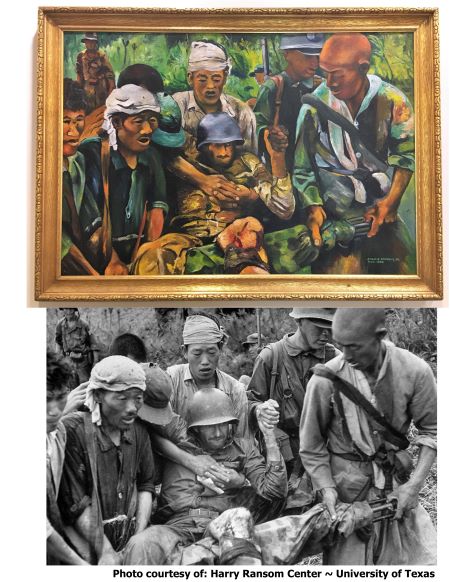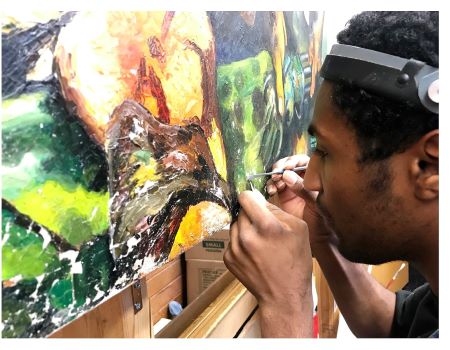
A new / old painting now hangs outside the second-floor office of the dean of the School of Education, Social Sciences and the Arts in Hazel Hall, a busy classroom building on the University of Maryland Eastern Shore campus.
“New” in the sense it was placed there this summer — for first the time — after a three-year restoration slowed by the COVID-19 pandemic.
“Old” in that the oil-on-canvas painting is an original work by Jimmie Mosely Sr., the late faculty member after whom the campus art gallery in the Thomas & Briggs Arts and Technology Center is named.
“Korean War Scene,” painted in 1953, depicts a wounded American soldier being carried to safety by what appears to be Korean peasants. A black-and-white news photo taken by the late David Douglas Duncan inspired Mosely’s work.
Duncan’s pictures were widely published in American print media because they captured the horrors of the conflict the Korean peninsula was experiencing just a decade following World War II.
Mosely’s 41-by-59 inch piece was stored in an archive room when a torrential rainstorm rolled across the lower Eastern Shore in mid-May 2018. The storm dumped nearly three inches of rain on Princess Anne, exposing an aging roof that subsequently allowed water to leak in.
The following day, Mosely gallery Director Susan Holt discovered “extensive water damage,” and sprang into action.
“I removed the painting, placed (it) horizontal (and) elevated (it) with towels underneath,” Holt said. Once her triage had stabilized it, she pivoted by “calling museum contacts.”
That eventually led to the University of Delaware, which takes on such projects to give hands-on experience to students training to be art conservators.

Restoration was overseen by Dr. Joyce Hill Stoner, a Delaware faculty fixture for four decades. The painting’s condition did not fluster her.
“We’re happy to have been asked to take this on,” said Stoner, director of the university’s Preservation Studies Doctoral Program.
The flaked paint — Stoner described as the “potato chip” effect — was typical of water damage.
Like UMES, the University of Delaware is a land-grant institution and one of three schools in the country that trains art conservators, Stoner said.
The Mosely painting took a painstaking 229 hours to restore, including 28 hours in a special humidity chamber, consolidating the raised “potato chip” curls, which took 65 hours, and another 60 hours of paint retouching.
Storer said Delaware has an interest in helping preserve and restore works by Black artists and is looking to recruit students of color to help diversify the profession. In addition to a humanities background, graduate students need to have a grasp of chemistry, too.
Delaware students also did research on the Mosely painting that made the connection to the Duncan image from 1950. The University of Texas is home to nearly 37,000 prints from Duncan’s long career as a photojournalist, including the one that inspired the Mosely piece.
The conservators did not charge for the work, some of which took place at the Winterthur Museum, Garden and Library outside Wilmington.
“We could not work on the painting in the Winterthur paintings studio … from March to September (2020), and no volunteers were allowed in until October,” Stoner wrote in a Jan. 15 e-mail to Holt.
By this past March, restoration was complete.
“I took my art history students on a field trip (May 5) to visit the conservation program and pick up the painting,” Holt said. “Students really enjoyed the field trip, which included (observing) textile and manuscript restoration.”
There, Holt received a 15-page report with “detailed color photos.”
“The UDel program is one of the best in the country,” Holt said. “We were so lucky.”
It turns out a Delaware benefactor donated an art collection to the university, which included “Humanity #2,” a 20-inch by 36-inch watercolor by Mosely, so Stoner was familiar with the signature on the Korean scene painting.
Marshall Stevenson, a historian and dean of the School of Education, Social Sciences and the Arts, said the Mosley painting resonated with him for several reasons; it reflects the creativity of a talented artist who captured an image from the Cold War’s early days that justified preservation.
Ten paces from Stevenson’s office is the Department of Physical Therapy. Stevenson said the restored painting deserved to be in a high foot-traffic area where physical therapy students, in particular, might find inspiration from the scene of someone who just might have required long-term care to overcome injuries.
The original black and white image that inspired this painting is in the archives of the Harry Ransom Center at the University of Texas at Austin.

